When Was the Upper Paleolithic Era and What Are Its Main Features
This is the fourth and concluding chapter of bigger human prehistory and anthropology research paper example. It demonstrates how our writers can tackle even the most difficult topics (for example, cultural innovations of the upper Paleolithic) as easy as shelling peas. Just imagine what they can do with smaller writing assignments and how could your academic performance skyrocket with their help!
Upper Paleolithic
This article is divided into parts:
- Part I: General context of human life in the Paleolithic
- Part II: The Lower Paleolithic
- Part III: The Middle Paleolithic
- Part IV: The Upper Paleolithic (this part)
This is the last and most recent part of the Paleolithic, or Old Stone Age. It marks an explosion in the cultural and technological sophistication of humans, as evidenced by their tool industries, paintings, sculpture, the beginnings of music, etc. Much of what we understand as modern human behavior appeared during the upper paleolithic.
Modern humans (Homo sapiens) have existed for somewhere between 160,000 - 190,000 years in Africa, where they first evolved. However, for much of this period, their technology and life style did not change much. There were other hominid species existing at the time (Homo neanderthalis and Homo heidelbergensis in Europe, Homo rhodesiensis in Africa, Homo erectus in Africa and Asia). Early modern humans did not invent a new culture or technology; their toolkit continued to be the same as that used by Neanderthals in west Asia and Europe.
The earliest evidence of modern human behavior goes back to the middle paleolithic, about 75,000 years ago in south Africa, where inhabitants of Blombos Cave made shell-bead strings for ornamentation and carved geometrical patterns into decorative ochre stones. Aterian sites in north Africa also have remains of pierced beads for personal adornment, dating back to 82,000 years ago. However, these developments were not sustained. The later record is patchy, with small communities in certain geographical areas leaving behind a few tantalizing evidences of sophistication, with larger intervening periods of more primitive culture. For the most part this modern human behavior disappeared around 65,000 years ago, only to reappear in the upper paleolithic, about 40,000 years ago.
There is much speculation about the reason for this patchy record. Some theories are biological, that is, they propose that certain key mutations that affected the brain allowed the development of modern human behavior. These may be related to language genes, or other genes which might confer modern human abilities, such as complex analytical thought. However, such theories have two problems - they don't explain the gaps in the archeological record, and they have no supportive fossil evidence. So far as the fossil evidence shows, completely modern humans have existed for 160,000+ years. Subtle changes in the brain would obviously leave no trace in the gross anatomy of the skull. Perhaps genome sequencing of present-day humans as well as human remains from 40,000 - 100,000 years ago might provide further insights in the future.
Another set of popular theories has to do with the storage and transmission of knowledge in societies. These may either have to do with human developments (such as the idea that perhaps language of sufficient complexity that allowed widespread easy dissemination of knowledge and culture only appeared late), or with demographics. One interesting idea is that in the absence of written language, a certain critical population density is needed before ideas can be retained for future generations. Adam Powell published a paper in Science (2009) describing a computer model of human population density and the appearance and spread of technologies in the archeological record. Their model seems to show that a certain population density is needed before people start migrating between groups, ensuring that inventions produced by one group are not lost over time. The model agrees well with the archeological record. If this is true, then such inventions may have appeared many times in the first 100,000+ years that modern humans have been around, but human populations were so sparse and widely scattered that the innovations were not able to take hold.
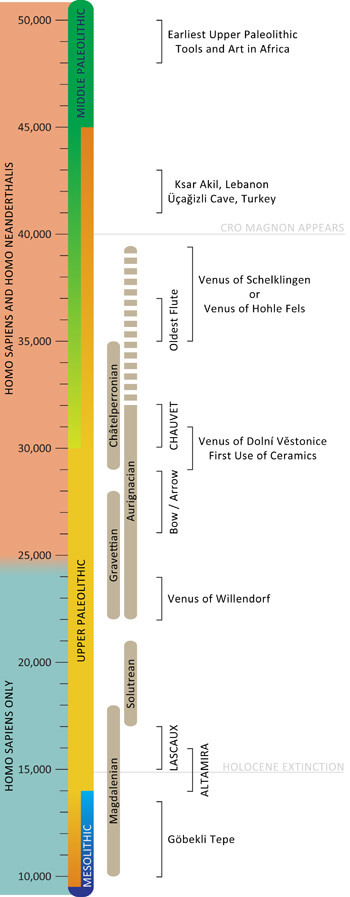
Much of the archeological work on the upper Paleolithic has been done in west Asia and Europe. For this reason, the archeological record is much more complete for west Asia and Europe, and the different periods of the upper Paleolithic are often described in terms of the European sites/cultures with which they correspond. This article is largely based on the European upper Paleolithic record, but it's important to remember that similar developments were taking place in the rest of Asia at about the same time.
Chatelperronian
This industry is named after the site in Châtelperron, in France, though it extended through southwest France into northern Spain. This is usually considered the oldest industry of the upper Paleolithic, dating to about 35,000 - 29,000 years ago. However, during this time, it was contemporary with the Aurignacian industry as well. It was originally thought that the Aurignacian started a bit later than the Châtelperronian, but recent finds have pushed back the earliest date of the Aurignacian to at least as far as the oldest known Châtelperronian sites, if not even earlier. Since the Châtelperronian is associated with Neanderthals, while the Aurignacian is associated with modern man, the Châtelperronian is still considered the more primitive (or sometimes, older) of the two. This is not strictly in accord with the radiocarbon dates, as mentioned.
This is a continuation of largely Mousterian techniques used during the middle stone age, but the tools produced are definitely more advanced than those produced with the same techniques earlier. Among the distinct tools are many denticulate or toothed tools, and thin flint knives with a single cutting edge and a blunt handle. The old Mousterian Levallois core method was used, usually with soft hammers made of bone or antlers.
There is a lot of use of ivory, more than is found at Aurignacian sites. Whether this has to do with the Neanderthal carnivorous lifestyle which included much mammoth hunting, is unknown. Antlers, on the other hand, are less frequently found. There is evidence for making jewelry at Châtelperronian sites, which is normally a feature of modern human, i.e., Aurignacian people.
Because of this mix of Mousterian and Aurignacian features, and also because of the interest in the nature of Neanderthal-human interaction, this is a fascinating period to many people. Excavations at some sites (such as Grotte des Fées) show evidence of interstratification of Châtelperronian and Aurignacian artifacts. That is, it appears that the site was originally occupied by Neanderthal people, and that at later periods, it was alternately occupied by Aurignacian people and Neanderthals, several times. The stratigraphy at many of these sites is not very clear (they were first excavated in the 19th century, when record keeping was often less exact), and it is difficult to establish exact dates, or even at times to be sure which layer a given artifact belong to.
The common view among archeologists seems to be that Châtelperronian culture was simply Neanderthal culture which became "modernized" due to Neanderthal contact with modern humans (Aurignacians). However, this is by no means a consensus, since many other archeologists argue that the modern techniques seen at these sites may well have been invented by Neanderthals. To some degree it depends on proving that Aurignacian people existed in the region at or before the time that Châtelperronian industry appears. Although there are problems with the stratigraphy, as mentioned above, it seems to be increasingly evident that there were indeed Aurignacians in the region at the time.
Even if Neanderthals did acquire the new technology from Aurignacian people, the question still remains: were these Neanderthal people of a modern "sensibility" in the sense of the Aurignacians. People have tried to argue for language and complex symbolic thought based on the presence of jewelry at Châtelperronian sites, but this is merely suggestive, and other explanations may account for it.
Some people prefer to think of the Châtelperronian as the first part of a longer tradition which includes the Gravettian culture. This longer tradition is termed the Périgordian, which extends from about 35,000 years ago up to 20,000 years ago. However, there are not enough known sites to prove a continuity of the two cultures, so it is difficult to prove. Some people even extend the same tradition to the proto-Magdalenian.
Aurignacian
This is the first modern human tradition of the upper Paleolithic, based on excavations of the type site of Aurignac, in France. This is usually thought to begin from about 35,000 years ago, and to end about 26,000 years ago. However, dating uncertainties leave open the possibility to push back the beginning as far as 40,000 years ago. In some places, it may have continued as late as 22,000 years ago.
Although most archeologists associate the Aurignacian culture with modern humans, this has not been conclusively proven. The oldest artifacts are either not found together with human remains, or the dating on the human remains is ambiguous. However, there is enough ancillary evidence for many people to believe that this was a culture of modern humans.
The Aurignacian marks the beginning of human art. The oldest "venus" figurine depicting a human figure dates from the early Aurignacian, the Venus of Hohle Fels, named after the cave in which it was discovered (in Germany), is about 35,000 - 40,000 years old. This is the earliest unambiguous representation of the human figure. The carving is small, about an inch in size and weighing about an ounce. It represents the headless body of a woman (it has a carved loop in place of the head, which was probably used to attach a string for use as a necklace).
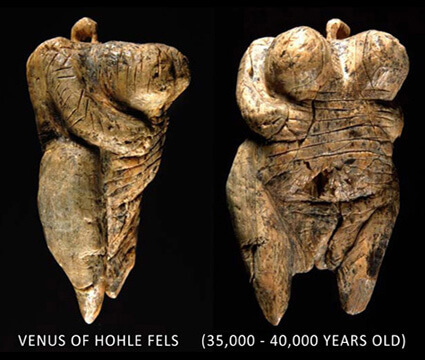
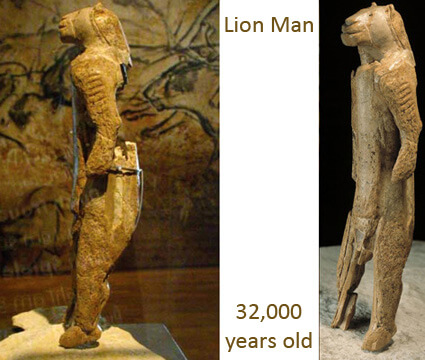
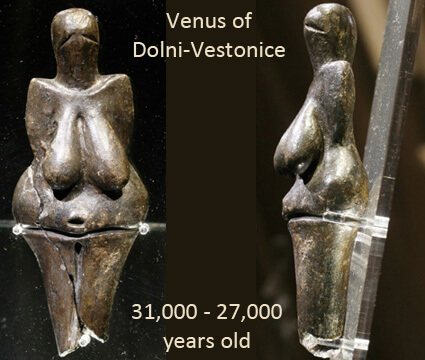
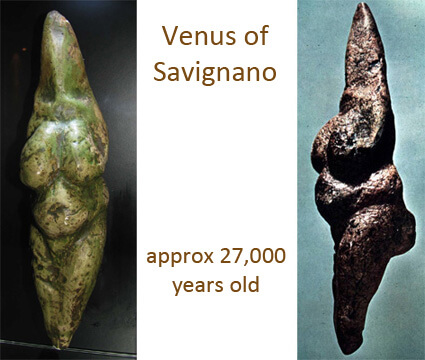
Other finds at nearby sites included the first figure of an animal - the lion man (or woman), which is about 32,000 years old. Hohle Fels cave also produced the first evidence of instrumental music, in the form of 2 ivory and 1 bone flutes. These flutes have been dated to approximately 35,000 - 40,000 years old. The bone flute is nearly complete, about 8.5 inches long (with probably 2-3 inches broken off and lost at the tail end), and made from a hollow bone from a griffon vulture. It includes the "mouthpiece" end, which consists of two v-shaped notches carved from opposite faces.
The earliest cave paintings also date from the Aurignacian, such as the rock at at Chauvet Cave in France, which has paintings 30,000 - 32,000 years old. This cave contains hundreds of paintings of animals, of 13 different species. Unlike other cave art which primarily show animals that were commonly hunted by men, Chauvet contains many representations of predatory animals such as lions, panthers, cave bears, etc. The paintings are very sophisticated, with shading and the use of perspective. Many paintings are carved or incised around the edges, to give a three-dimensional effect. It must have been very dramatic by torchlight, with the shadows cast by the carvings.
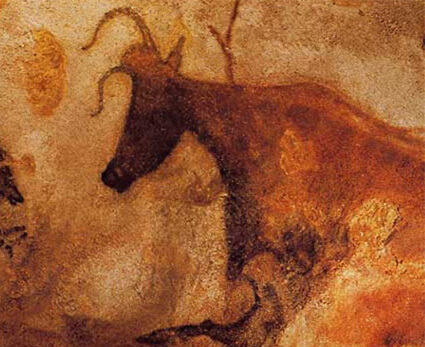
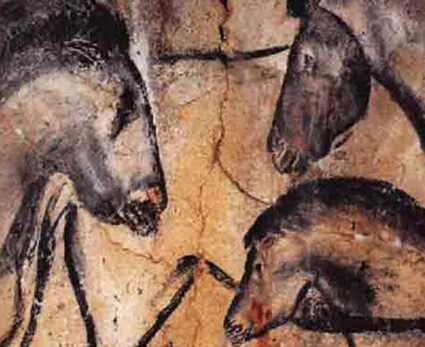
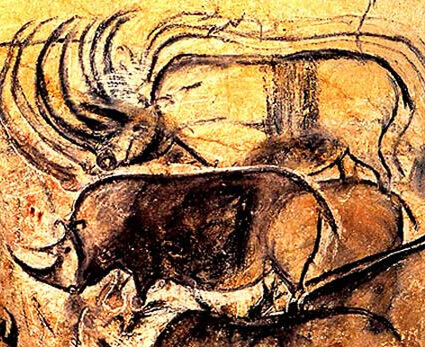
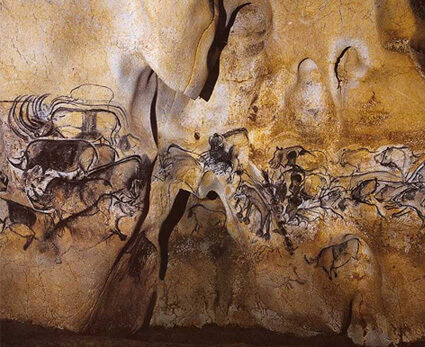
In addition to the paintings, the cave also has many other human artifacts. In several places, the walls show hand prints, made by covering the hand with pigment, and then pressing it against the wall. Several abstract markings, consisting of lines and dots appear throughout the cave. There are also a child's footprints, though these are believed to date from a later Gravettian occupation of the cave (about 26,000 - 27,000 years ago).
Various adornments dating from the same period have also been found, including necklaces, bangles, small animal figurines which were probably worn or attached to clothes, etc. The stone tool industry is complex, consisting of finely shaped blades, as well as bone and antler tools such as needles and harpoons.
Gravettian
The Gravettian culture is dated to approximately 28,000 to 22,000 years ago, based on the type site at La Gravette in France. It followed the Aurignacian culture, and at many sites, Aurignacian artifacts are found preceding Gravettian artifacts. It's characterized by small, pointed restruck blades, with blunt, straight backs. Another characteristic tool from this period is the burin, specifically a type of burin known as the Noailles burin. These are stones with a chisel edge, that were probably used very much like chisels, probably for engraving and carving wood or bone.
This was the last culture before the glaciation, and the climate was cooling rapidly during this time. The Gravettian was primarily a hunting culture, like the Neanderthals, but very mobile and adapted for its time. It seems likely that Gravettian people were more efficient hunters than the Neanderthals, and since this period marks the disappearance of the Neanderthals, it's been speculated that part of the reason may have been that the Gravettians outcompeted them for food, in a time of increasing cold and declining resources.
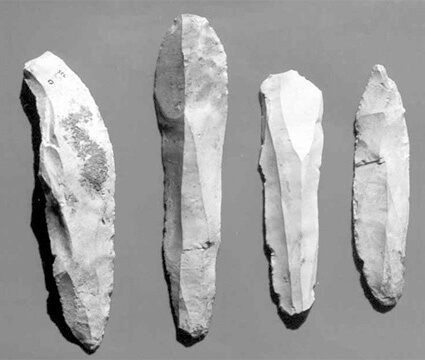
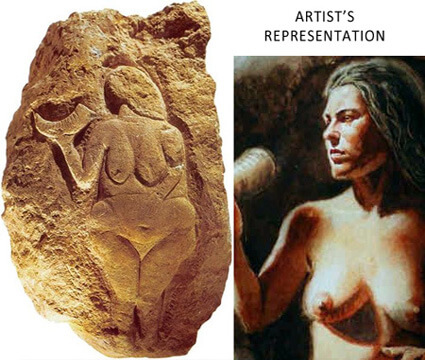
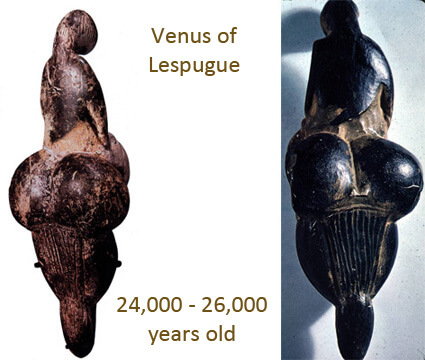
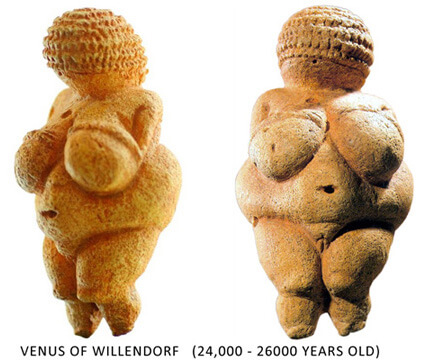
Gravettian weapons were probably similar to those of the neanderthals - clubs, spears, sticks, etc., which probably means that like the Neanderthals, they hunted animals at close range. However, unlike the Neanderthals, they were very mobile, and moved their settlements frequently to places where animals were likely to congregate. Gravettian settlements were located in the paths of migrating herds, usually in narrow valleys where the herds went through bottlenecks in the terrain.
Rope imprints found in clay suggest that the Gravettians used nets to trap smaller animals. This would have been an efficient method to catch a large number of animals in a short time, leading to a more constant food supply, to tide over the feast/famine cycles of hunting large animals. Gravettians relied mostly on meat for their sustenance. The cold climate made plant food scarce, and meat/fat was needed to survive the cold.
Because of the considerable hunting, Gravettian people used a lot of animal products in their lifestyle. Bone tools are very common from this period, being used for diverse objects such as needles, barbs, hooks, etc. Bones and teeth were also used for decorative purposes. Pierced teeth have been found, which indicate that they may have been used for making bangles or necklaces. An enormous number of venus figurines are found from this period, including the famous Venus of Willendorf, which is about 25,000 years old. These figurines were typically small (an inch or two in size) and had no feet, indicating that they could not be stood up. They may have been used as decorative or ritual objects. The grossly exaggerated female characteristics suggest that they might have played a part in a fertility cult.
Solutrean
This is a relatively short period based on the type site of Solutre in France, that lasted from about 17,000 - 21,000 years ago. This period occurs during the last glacial maximum, and the climate was very cold. The period is distinguished by the very fine workmanship of its tool making industry. Blades in the shape of laurel leaves (Solutrean points) were very common. Initially, Solutrean points were unifacial, but in later stages of the Solutrean they became bifacial.
Bone needles with eye holes are common from this period, indicating the use of fitted clothing. This must have been specially important in the cold climate. Ornaments in the form of bead bracelets and necklaces, pendants, pins, etc. are also very common. Many tools have bizarre, asymmetrical shapes, and some laurel points are so thin as to be practically useless. These tools seem to suggest that tool making was not only for utility, but they produced luxury goods as well.
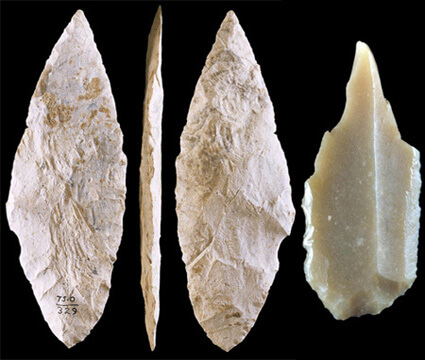
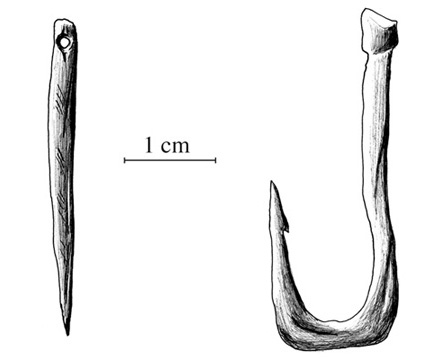
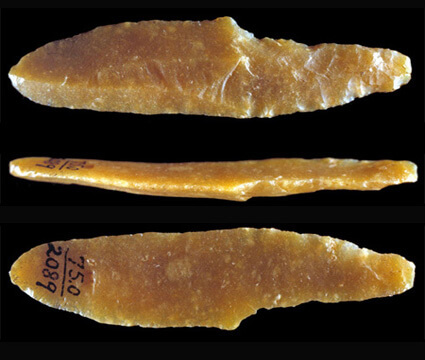
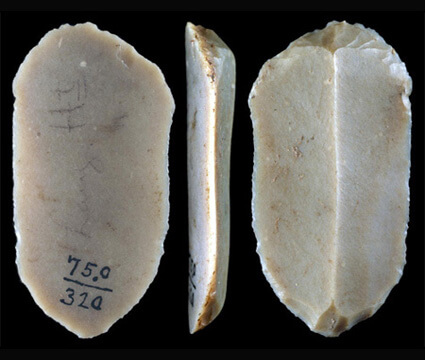
Solutrean tools were made with pressure flaking, rather than the older, cruder flint knapping technique. This allowed the creation of very thin and finely shaped tools. Light and elaborately shaped arrowhead from this period are found. Although it's possible that the bow and arrow was invented earlier (there is some evidence of arrowheads from the Gravettian), the Solutrean shows many examples of finely crafted arrowheads, indicating that bows were probably in use.
Magdalenian
The Magdalenian is named after the type site at La Madeleine, a rock shelter in France. This was one of the last cultures of the paleolithic, existing from about 18,000 to 10,000 years ago. This was a period when bison, reindeer and wild horses roamed the countryside in large herds. People lived a semi-settled life, in caves and rock shelters in the winter, and in tents in summer. The first known villages are from this period, usually located at riversides, and numbering 400-600 people. There was a population "explosion" during this period - it's estimated that the population of France went from about 15,000 people in the Solutrean to about 50,000 people in the Magdalenian. The culture was widespread, from Portugal in the west to Poland in the east.
The Magdalenian is divided into 6 phases, based on stratigraphy. The oldest Magdalenian sites are all found in France, so the culture spread from France into neighboring areas. The climate was still cold, as Europe was recovering from the last glacial maximum. Reindeer herds were very abundant across Europe, and reindeer hunting was one of the chief occupations of Magdalenian people.
Magdalenian tools show a preponderance of bone and antler tools, and less reliance on the flint industry. These tools are generally smaller, and very varied. Barbed bone points are very common (sometimes considered harpoon tips), as well as javelin points, eyed needles, spear throwers, "batons", chisels, etc. Stone tools include toothed blades and scrapers, burins and borers, as well as parrot-beak gravers. Bone tools were often carved with pictures of animals, which are a common motif in all Magdalenian art. Towards the end of the Magdalenian, there was a strong trend towards microlithization. Very small bone and stone tools with complicated barbs are found.
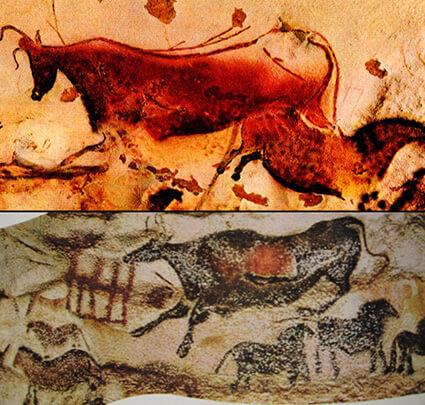
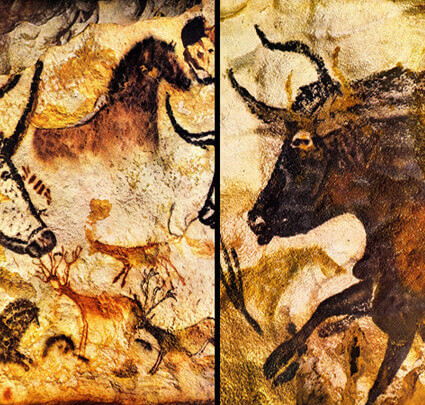
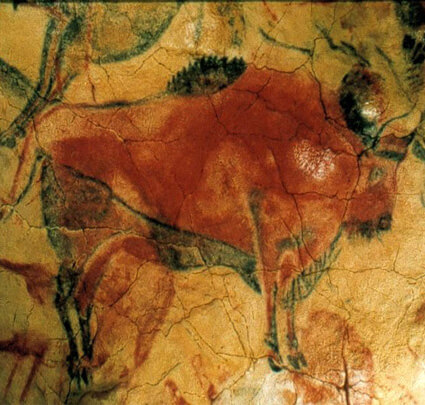
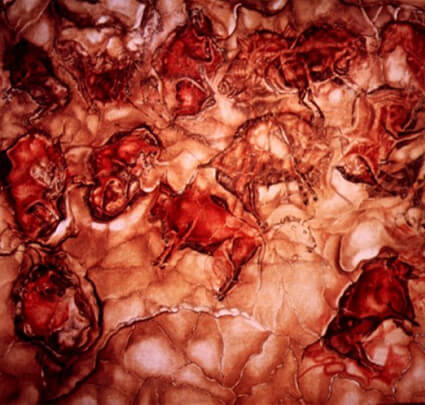
Magdalenian art started as simple line art, very much cruder and simpler than the heights of the Aurignacian achievements, such as those seen at Chauvet. However, over time Magdalenian art improved tremendously, with detailed engravings using several colors. Late Magdalenian art is known for its realism and expressive poses, from sites such as Lascaux in France and Altamira in Spain. Some of the best paleolithic sculpture was also produced in this period, as well as many items of jewelry, including beads, bangles and necklaces, pendants, amulets, etc.
The Magdalenian ended about 10,000 - 12,000 years ago, as the climate warmed and the large herds of reindeer disappeared or moved further north. Cultures which followed were much less elaborate, and lacking the grand artistic traditions of the Magdalenian.
Yeah, now you know what is the upper Paleolithic. Fascinating, right? But much more important knowledge you've gained is that EssayWeb.net can deliver you a paper of any type, complexity, and size and do it at an unbeatable price! So step on the gas, push the button below and start performing better in college!
Cite the page
- APA
- MLA
- Harvard
- Vancouver
- Chicago
- ASA
- IEEE
- AMA
If you want a unique paper, you can have one of our writers create it for you
Ours Services
Related Essays
Academic Essays Database Has All You Need to Succeed
- Essay
- Research Paper
- Case Study
- Report
- Critical Thinking
- Article Review
- Argumentative Essay
- Term Paper
- Literature Review
- Business Plan
- Research Proposal
- Creative Writing
- Cover Letter
- Dissertation Conclusion
- Dissertation Methodology
- Dissertation Proposal
- Dissertation Abstract
- Dissertation Hypothesis
- Dissertation Chapter
- Dissertation Results
- Dissertation Introduction
- Thesis
- Thesis Statement
- Business Proposal
- Biography
- Annotated Bibliography
- Admission Essay
- Movie Review
- Thesis Proposal
- Personal Statement
- Coursework
- Book Review



